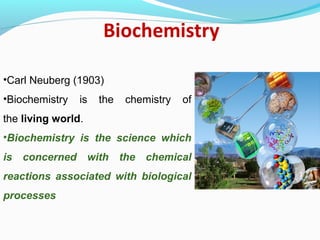Water has unique properties that make it essential for life. It is polar and can form hydrogen bonds, giving it high surface tension and allowing it to be an excellent solvent. Water also has a high heat capacity and heat of vaporization, enabling it to buffer temperatures. Its density peaks at 4°C, and it is less dense as a solid due to its crystalline structure - properties important for organisms. Overall, water's polarity and ability to form bonds give it characteristics that sustain all known lifeforms.



![DEFINITIONS
Biotechnology is the application of scientific and
engineering principles to the processing of materials by
biological agents to provide goods and service. [The
Organization for Economic Cooperation and
Development (OECD), 1981].
The integrated use of biochemistry, microbiology and
engineering sciences in order to achieve technological
application of the capabilities of microorganisms,
cultured tissue, cells, and parts their
of [The European Federation of Biotechnology
(EFB)]](https://image.slidesharecdn.com/mahanthesh-180521045650/85/WATER-4-320.jpg)




































